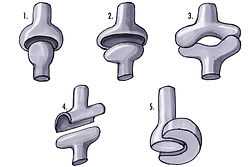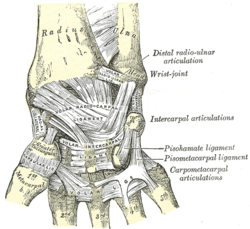Condyloid joint
| Condyloid joint | |
|---|---|
 1: Ball and socket joint; 2: Condyloid joint (Ellipsoid); 3: Saddle joint; 4 Hinge joint; 5: Pivot joint; | |
 Ligaments of wrist. Anterior view | |
| Details | |
| Latin | articulatio ellipsoidea |
| Identifiers | |
| Gray's | p.285 |
| Dorlands /Elsevier | a_64/12161206 |
| TA | A03.0.00.049 |
| Anatomical terminology | |
A condyloid joint (also called condylar, ellipsoidal, or bicondylar[1]) is an ovoid articular surface, or condyle that is received into an elliptical cavity. This permits movement in two planes, allowing flexion, extension, adduction, abduction, and circumduction.
Examples
Examples include:[2]
- the wrist-joint
- metacarpophalangeal joints
- metatarsophalangeal joints
These are also called happy joints. Oval shaped condyle of one bone fits into elliptical cavity of other bone. These joints allow biaxial movements i.e foreword-backward and side to side but not rotation. Radius carpal, Metacarpo- phalangeal joints are examples of condyloid joint.
References
This article incorporates text in the public domain from the 20th edition of Gray's Anatomy (1918)
- ↑ Rogers, Kara (2010) Bone and Muscle: Structure, Force, and Motion p.163
- ↑ Module - Introduction to Joints
| Wikimedia Commons has media related to Condyloid joints. |
| ||||||||||||||||||||||||||||||||||||